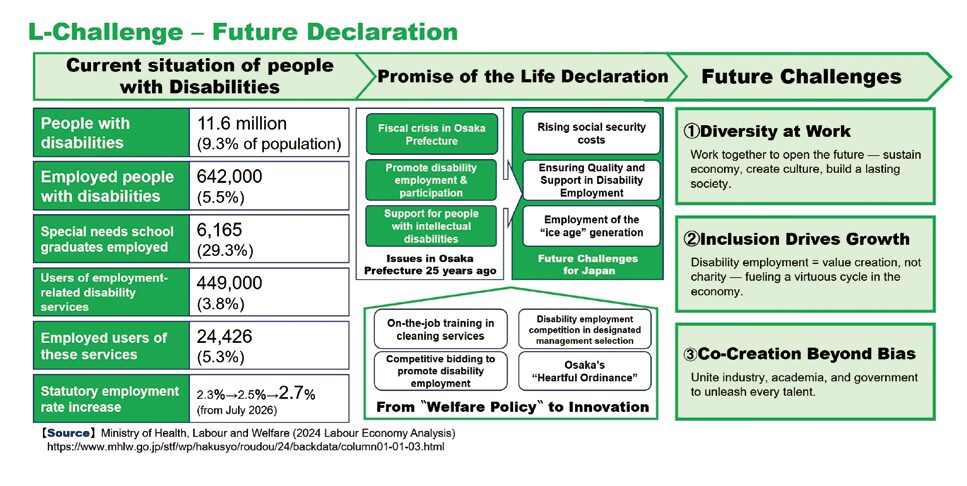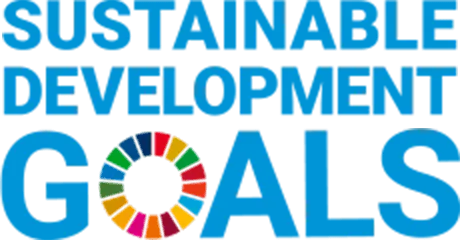Inochi Declaration
Support starting to work and continuing to work for everyone by shifting public procurement from price competition to competition on employment quality and strengthening intermediary support organizations that focus not just on the number but also the quality of employment.
Let us look back at the situation of people with intellectual disabilities in Japan 25 years ago. In 1998, intellectual disabilities were included in the calculation basis for the statutory employment rate. In 1999, the derogatory legal term “seishin hakujaku” (mental retardation) was changed to “intellectual disability.” In 2000, with the structural reform of social welfare, service use shifted from “administrative measures” to “user contracts”. While the overhaul of employment-related service systems would come later (2006), at the time, local governments were struggling to promote employment support for people with intellectual disabilities.

During that period, an idea was born in Osaka Prefecture: the “Welfare of the Government*1” initiative. Facing a fiscal crisis, Osaka chose not to allocate new budgets but to leverage existing programs and resources to create employment and work opportunities for people with disabilities and others needing support. One key focus was cleaning services, which matched the strengths of people with intellectual disabilities. By adding the value of vocational training for people with intellectual disabilities to cleaning contracts, Osaka introduced a comprehensive evaluation competitive bidding system that considered not only price but also disability employment outcomes. This approach generated significant employment opportunities. Today, building maintenance companies participating in cleaning bids for large Osaka Prefecture facilities maintain a disability employment rate of over 10%, transforming the industry itself into a social enterprise.
L-Challenge, the cooperative undertaking vocational training contracts, was recognized in 2019 as Osaka Prefecture’s first “Support Organization for Improvement of Work Environment for Persons with Disabilities”*2. Its role is to stand between companies contracted by the prefecture and the employees with disabilities, creating workplaces that are truly inclusive—not simply outsourcing arrangements aimed at meeting legal disability employment quotas*3. While hiring people with disabilities to meet the statutory employment rate is one thing, what matters is to move beyond mere compliance: companies must review their operations, invest in developing the abilities of employees with disabilities, and integrate them as active contributors to their workforce. L-Challenge has worked together with companies to create workplaces characterized by both consideration and rigor, enabling people with disabilities to become valued team members.
By 2050, Japan’s population is projected to shrink to about 95 million, with the elderly population increasing by approximately 12 million and the working-age population decreasing by 35 million. With ballooning social security costs and dwindling tax revenues, sustaining the traditional welfare system will become increasingly difficult. Osaka’s comprehensive evaluation bidding system was assessed in 2017 through a social cost estimation study, comparing the additional costs of comprehensive evaluation bidding to the benefits from reduced social security expenditures*4.
The results demonstrated the policy’s cost-effectiveness and spurred the revision of Osaka Prefecture’s Heartful Ordinance in 2018*5. Similar employment support ordinances have also been enacted in other areas, such as Fuji City’s Universal Employment Ordinance (2017) and Tokyo Metropolitan Government’s Social Firm Ordinance (2020)*6*7.
Looking toward 2050, the Inochi Forum aims to expand the 25 years of experience in Osaka’s “Welfare of the Government” to other municipalities and businesses, ultimately evolving it into the broader “Welfare-Integrated Osaka.”
Working with organizations such as L-Challenge, we will promote public procurement systems with policy objectives, contributing to the creation of a society where everyone can start working and continue working.
[Notes]
*1 Osaka Prefecture, “Welfare of the Government”:
*2 Osaka Prefecture, “Support Organization for Improvement of Work Environment for Persons with Disabilities”:
https://www-pref-osaka-lg-jp-e.athp.transer.com/o090060/keikakusuishin/syuuroushien/syokubakankyou.html
*3 Ministry of Health, Labour and Welfare, Disability Employment Subcommittee, Labor Policy Council – 128th Meeting Materials:
https://www.mhlw.go.jp/content/11704000/001087755.pdf
*4 Osaka Prefecture, “Evaluation of Welfare-Integrated Administration: Social Cost Estimation Study”: https://www.pref.osaka.lg.jp/documents/5874/gyofukukachousa1.pdf
*5 Osaka Prefecture, “Revised Heartful Ordinance (2018)”: https://www.pref.osaka.lg.jp/documents/5874/heartfulchirasi.pdf
*6 Fuji-City, “Universal Employment Ordinance (2017)”: https://www.city.fuji.shizuoka.jp/kurashi/c0606/universal_work.html
*7 Tokyo Metropolitan Government, “Social Firm Ordinance (2020)”:
https://www.social-firm.metro.tokyo.jp
[References]
・L-Challenge:
・NPO Welfare Town Development Practice Organization:
https://wep-npo.com/
[Action Platform]
Economy, Employment and Poverty / Diversity and Inclusion
[SDGs]



